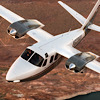23 Apr 2024, 03:24 [ UTC - 5; DST ]
|

| Username Protected |
Message |
|
Username Protected
|
Post subject: Re: Turbine step up?  Posted: Posted: 23 Jan 2019, 17:10 |
|
 |

|
|

Joined: 05/31/13
Posts: 1235
Post Likes: +602
Company: Docking Drawer
Location: KCCR
Aircraft: C425
|
|
Quote: You're buying more than an engine, you're buying years and years of support and liability. CMI and Lycoming exist because we pay them enough to operate, supplying parts and service and responsibility for these dinosaurs. There's not much of a market and there's a high burden for every engine in service. This is exactly correct. And the same goes for turbines as well, except add a decimal point. I can get all the parts, service, and support I need for an engine model that was last produced in 1985.
_________________
ATP, CFI-I, MEI
http://www.dockingdrawer.com
|
|
| Top |
|
|
Username Protected
|
Post subject: Re: Turbine step up?  Posted: Posted: 24 Jan 2019, 09:29 |
|
 |

|
|
 |

Joined: 11/25/16
Posts: 1822
Post Likes: +1382
Location: 2IS
Aircraft: C501
|
|
Username Protected wrote: We can't compare them to car engines, where the engineering and other costs are amortized across a couple of orders of magnitude more units. I'm not trying to be stubborn Larry, but when was the last time Lycoming or CMI had any significant engineering/R&D costs on the piston GA fleet?
|
|
| Top |
|
|
Username Protected
|
Post subject: Re: Turbine step up?  Posted: Posted: 24 Jan 2019, 11:17 |
|
 |

|
|

Joined: 05/31/13
Posts: 1235
Post Likes: +602
Company: Docking Drawer
Location: KCCR
Aircraft: C425
|
|
|
Lycoming has their iE2 engine that's going in the Tecnam Traveller. It has single lever power, electronic control (and timing I guess), pushbutton start. But it took a customer (Cape Air) and an OEM (Tecnam) to commit to a certain number of units for them to do it, I would imagine. If Cirrus told CMI they are going to switch to Lycoming unless they certify an engine with electronic control, I bet they would do it. It all derives from demand. If CMI and Lycoming don't believe they will sell any more engines even after a significant amount of development work, then why do it? They both tried the Jet-A thing and it got them nowhere.
_________________
ATP, CFI-I, MEI
http://www.dockingdrawer.com
|
|
| Top |
|
|
Username Protected
|
Post subject: Re: Turbine step up?  Posted: Posted: 24 Jan 2019, 18:44 |
|
 |

|

|
 |

Joined: 07/21/08
Posts: 5469
Post Likes: +6185
Location: Decatur, TX (XA99)
Aircraft: 1979 Bonanza A36
|
|
Username Protected wrote: So why do they cost so darn much? Is the manufacturing process and materials 5x more complicated and expensive than a piston engine? Has anyone ever tried to build a cheap turbo prop (other than these guys: http://www.turbinesolutiongroup.com) Although the operating principle is simple, just spinning wheels, the realization of a working engine is pretty complex. Specialized materials, precise tolerances and the creation of things we don't think about like air passages in turbine blades to create air films over the blade surfaces so it doesn't burn in operation. If you look at a single turbine blade from a very modern jet engine, you'll see just how complex they are to make, with lots of tiny passages drilled through extremely tough alloys. Then there are hundreds of them, perfectly made in every engine.
The other thing you fight in building turbine engines is the physics of squeezing air through small passages. Large turbine engines over 500hp, are more reasonable than building small turbines of say, 100hp. Smaller sizes make it more difficult or impossible to implement things like air film cooling, which means you can't operate them as hot, which means they're not as efficient. Fuel specifics are much better on a large turboshaft engine of a few thousand HP, than they are of a 250hp small turboshaft engine. Reciprocating engines make a lot of sense under 300hp. Turbines start to make sense above 300hp. I think the expense of current piston engines for aircraft are telling of the industry. You're buying more than an engine, you're buying years and years of support and liability. CMI and Lycoming exist because we pay them enough to operate, supplying parts and service and responsibility for these dinosaurs. There's not much of a market and there's a high burden for every engine in service. We can't compare them to car engines, where the engineering and other costs are amortized across a couple of orders of magnitude more units.
precision 3d printing should be making this a mute point. One of our own, John Murray, is an expert at the process. Hopefully he will chime in and shed some light on the subject.
It seems to me that the printing process should be driving the cost down by a significant factor but, alas, it doesnt seem to be happening.
_________________
I'm just here for the free snacks
|
|
| Top |
|
|
Username Protected
|
Post subject: Re: Turbine step up?  Posted: Posted: 24 Jan 2019, 20:18 |
|
 |

|
|


Joined: 12/03/14
Posts: 19252
Post Likes: +23622
Company: Ciholas, Inc
Location: KEHR
Aircraft: C560V
|
|
Username Protected wrote: precision 3d printing should be making this a mute point. Only if can match or exceed the material properties of machined blades. Last I knew, 3D printing had not done that as of yet. Mike C.
_________________
Email mikec (at) ciholas.com
|
|
| Top |
|
|
Username Protected
|
Post subject: Re: Turbine step up?  Posted: Posted: 24 Jan 2019, 20:58 |
|
 |

|
|
 |


Joined: 08/20/09
Posts: 2407
Post Likes: +1880
Company: Jcrane, Inc.
Location: KVES Greenville, OH
Aircraft: C441, RV7A
|
|
Username Protected wrote: precision 3d printing should be making this a mute point. Only if can match or exceed the material properties of machined blades. Last I knew, 3D printing had not done that as of yet. Mike C.
The point was already mute though. 
_________________
Jack Stull
|
|
| Top |
|
|
Username Protected
|
Post subject: Re: Turbine step up?  Posted: Posted: 24 Jan 2019, 22:55 |
|
 |

|

|
 |

Joined: 07/21/08
Posts: 5469
Post Likes: +6185
Location: Decatur, TX (XA99)
Aircraft: 1979 Bonanza A36
|
|
Username Protected wrote: precision 3d printing should be making this a mute point. Only if can match or exceed the material properties of machined blades. Last I knew, 3D printing had not done that as of yet. Mike C.
literally 3 seconds of Google research....
https://www.google.com/search?q=3d+prin ... e&ie=UTF-8
_________________
I'm just here for the free snacks
|
|
| Top |
|
|
Username Protected
|
Post subject: Re: Turbine step up?  Posted: Posted: 24 Jan 2019, 23:02 |
|
 |

|

|
 |

Joined: 07/21/08
Posts: 5469
Post Likes: +6185
Location: Decatur, TX (XA99)
Aircraft: 1979 Bonanza A36
|
|
|
From the GE article:
"The 3D printing factory, which looks like a blue and gray jewel box of steel and glass from the outside, holds 20 black, wardrobe-sized 3D printers, made by Arcam. A single machine can simultaneously print six turbine blades directly from a computer file by using a powerful 3-kilowatt electron beam. The beam “grows” the blades, which are 40 centimeters long, by welding together thin layers of titanium aluminide powder, one after another.
Jet engine designers love this strong, heat-resistant wonder material, also known as TiAl. It weighs 50 percent less than the metal alloys typically used in aviation. But TiAl is also very brittle. Until 3D printing came along, the only way to shape it involved molding, a somewhat dirty process that requires expensive tools. “This factory has helped us understand what the art of the possible is with additive manufacturing,” said David Joyce, president and CEO of GE Aviation."
Please tell me why these engines have not decreased in price....
_________________
I'm just here for the free snacks
|
|
| Top |
|
|
Username Protected
|
Post subject: Re: Turbine step up?  Posted: Posted: 25 Jan 2019, 00:41 |
|
 |

|
|
 |

Joined: 06/06/12
Posts: 2290
Post Likes: +2114
Company: FlightRepublic
Location: Bee Cave, TX
Aircraft: DA40, C182
|
|
Username Protected wrote: From the GE article:
"The 3D printing factory, which looks like a blue and gray jewel box of steel and glass from the outside, holds 20 black, wardrobe-sized 3D printers, made by Arcam. A single machine can simultaneously print six turbine blades directly from a computer file by using a powerful 3-kilowatt electron beam. The beam “grows” the blades, which are 40 centimeters long, by welding together thin layers of titanium aluminide powder, one after another.
Jet engine designers love this strong, heat-resistant wonder material, also known as TiAl. It weighs 50 percent less than the metal alloys typically used in aviation. But TiAl is also very brittle. Until 3D printing came along, the only way to shape it involved molding, a somewhat dirty process that requires expensive tools. “This factory has helped us understand what the art of the possible is with additive manufacturing,” said David Joyce, president and CEO of GE Aviation."
Please tell me why these engines have not decreased in price.... I believe the technology is being developed for the GE Catalyst, to be used in the Cessna Denali. I guess we’ll have to wait to learn what the effects on price will be.
_________________
Antoni Deighton
contactlink.to/antoni.deighton
|
|
| Top |
|
|
Username Protected
|
Post subject: Re: Turbine step up?  Posted: Posted: 25 Jan 2019, 01:29 |
|
 |

|
|
 |

Joined: 01/30/09
Posts: 3353
Post Likes: +1963
Location: $ilicon Vall€y
Aircraft: Columbia 400
|
|
Username Protected wrote: We can't compare them to car engines, where the engineering and other costs are amortized across a couple of orders of magnitude more units. I'm not trying to be stubborn Larry, but when was the last time Lycoming or CMI had any significant engineering/R&D costs on the piston GA fleet?
While there hasn't been much in the way of outright new designs, it is pretty certain that a decent amount of engineering money is spent.
Things change, materials change, suppliers change, processes change, parts get updated. Stuff breaks, accidents get investigated, crankshafts and other parts that aren't supposed to break, break, AD's get issued and corrective measures get designed.
It takes engineers to sort all that, update processes, write the validation plan and collect data, verify it works sign the papers.
There are things like this:
https://www.youtube.com/watch?v=q3-cmKt6v6Y
Where Lycoming switched from the ammonia furnace to plasma chamber for nitriding. Pretty significant investment there.
There have been various introductions over the years, like the Tiara engines, FADEC, the experimental engines and so on.
We're not going to see a clean sheet engine from them. There's just not money enough to make it happen.
|
|
| Top |
|
|
Username Protected
|
Post subject: Re: Turbine step up?  Posted: Posted: 25 Jan 2019, 11:14 |
|
 |

|
|

Joined: 12/30/15
Posts: 714
Post Likes: +740
Location: NH; KLEB
Aircraft: M2, erstwhile G58
|
|
[ Username Protected wrote: precision 3d printing should be making this a mute point. Only if can match or exceed the material properties of machined blades. Last I knew, 3D printing had not done that as of yet. Mike C.
[/quote]
3D printing or additive manufacturing is certainly a great technology. Of course, like everything else it will have its limitations. Most of the aviation stuff is still made in a conventional manner. Near net, or as close as they can, forgings and then conventional machining. There is something about a forging that imparts tremendous performance properties. This is particularly critical with high temp alloys. Will the get there with 3D technology? Maybe... are they there yet in terms of widespread use & commercialization? No.
|
|
| Top |
|
|
Username Protected
|
Post subject: Re: Turbine step up?  Posted: Posted: 25 Jan 2019, 14:21 |
|
 |

|
|
 |

Joined: 11/06/10
Posts: 11898
Post Likes: +2854
Company: Looking
Location: Outside Boston, or some hotel somewhere
Aircraft: None
|
|
Username Protected wrote: 3D printing or additive manufacturing is certainly a great technology. Of course, like everything else it will have its limitations. Most of the aviation stuff is still made in a conventional manner. Near net, or as close as they can, forgings and then conventional machining. There is something about a forging that imparts tremendous performance properties. This is particularly critical with high temp alloys. Will the get there with 3D technology? Maybe... are they there yet in terms of widespread use & commercialization? No. If you dig through the GE material and press. GE is there now. As engines, parts and other items get redesigned, they are going to move more and more to addative manufacturing. Tim
|
|
| Top |
|
|
Username Protected
|
Post subject: Re: Turbine step up?  Posted: Posted: 25 Jan 2019, 17:28 |
|
 |

|
|
 |

Joined: 08/09/11
Posts: 1735
Post Likes: +2054
Company: Naples Jet Center
Location: KAPF KPIA
Aircraft: EMB500 AC95 AEST
|
|
Username Protected wrote: As far as I know there are no complex cooling channels in any of the turbine blades on the common turboprop GA engines. Don't think the PT6 has any, not does the TPE331 or the RR250. They're just slabs of shaped metal. Also, all the common TP engines precede automated CNC machining, so at some point someone milled these entirely manually on a lathe/mill. Which makes it a little surprising they cost so much. Adam, I don’t have a pic handy but unlike the -1, -5, -6 etc., a -10 1st stage blade has internal air cooling and are $1,000/each, approximately.
|
|
| Top |
|
|
Username Protected
|
Post subject: Re: Turbine step up?  Posted: Posted: 25 Jan 2019, 20:35 |
|
 |

|
|

Joined: 11/22/08
Posts: 2921
Post Likes: +928
Company: USAF Propulsion Laboratory
Location: Dayton, OH
Aircraft: PA24, AEST 680, 421
|
|
|
Addictive manufacturing is a great technology for making complex parts such as cooled turbine blades, heat exchangers, etc. However, the process is not as simple as many believe. The material properties are not the same as conventional manufacturing processes. Printing is a slow process, not necessarily less expensive than conventional processes. In addition, most of the materials used in turbine engines tend to be expensive. Most modern engines the turbine is subjected to temperatures above the melting point of the metal. These high temperatures mean improved performance which most everyone desires.
|
|
| Top |
|
|
You cannot post new topics in this forum
You cannot reply to topics in this forum
You cannot edit your posts in this forum
You cannot delete your posts in this forum
You cannot post attachments in this forum
|

Terms of Service | Forum FAQ | Contact Us
BeechTalk, LLC is the quintessential Beechcraft Owners & Pilots Group providing a
forum for the discussion of technical, practical, and entertaining issues relating to all Beech aircraft. These include
the Bonanza (both V-tail and straight-tail models), Baron, Debonair, Duke, Twin Bonanza, King Air, Sierra, Skipper, Sport, Sundowner,
Musketeer, Travel Air, Starship, Queen Air, BeechJet, and Premier lines of airplanes, turboprops, and turbojets.
BeechTalk, LLC is not affiliated or endorsed by the Beechcraft Corporation, its subsidiaries, or affiliates.
Beechcraft™, King Air™, and Travel Air™ are the registered trademarks of the Beechcraft Corporation.
Copyright© BeechTalk, LLC 2007-2024
|
|
|
|



